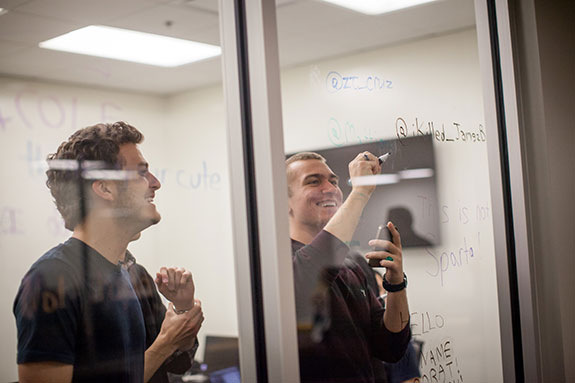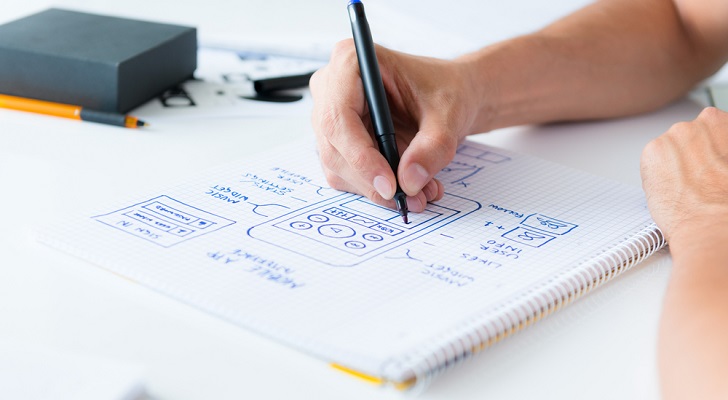How Do I Think of an App Idea
Many considerations go into pricing an app, typically $75,000 can get your app up and running barebones. Here at Fueled a project can run on average $300,000 with an upper limit of $1,000,000 but with that investment you allow us to act on critical development opportunities, some which may truly aid you in realizing your vision.
Do you have a great idea for an app?
With the app economy booming, it is the time to transition your vision for an app into a reality. The user base is growing with the sales of smartphones. Apps are worth approximately $6 billion this year. It’s an amazing opportunity for entrepreneurs and enterprise companies alike. Can you pull it off? With a plan and guide, even an inexperienced entrepreneur or individual without coding capabilities can successfully turn their app idea into a reality.
We asked Fueled Strategist Perry Curac-Dahl to break down the process of building an app into four phases.
These steps will take an app all the way from an idea to a minimum viable product (MVP) that is ready to be released, reviewed and improved.

What Is a Minimum Viable Product?
An MVP is the early version of an app or product that is developed only with a minimal feature set. The idea is to test your hypothesis and then expand upon the offerings with iterative releases. Typically, once feedback is received from users, the app will be developed with a more complete set of features. Although people imagine a feverish hack-a-thon when they picture the app development process, much of the legwork is actually done in phase one. This is when market assumptions and design wireframes are being evaluated. Proper diligence here reduces the workload and cost when developers are working with product strategists and designers on the product.
1. Identify the Problem

Before enlisting the help of an app development agency, Curac-Dahl recommends taking the time to identify and hone in on the “underlying problem” that you want your app to mitigate. You will ask yourself, How is your app going to change the world? Why do we need your app?
At this point, you don’t need to worry about the specific elements of your app, such as its minor design details, but you should be strongly focused on the issue that your app is here to fix. For a user to download your app, open your app, and integrate your app into their daily routine, it needs to give them something. It needs to solve a problem or hold value for the user. (A truly successful app will manage to do both.)
You want to focus on the problem, so don’t immediately jump into trying to determine the solution. The discovery phase can turn up unexpected gifts. Instagram set out to solve a different problem than it eventually focused on, offering users a way to check into a place and upload photos to share, rather like FourSquare. In the end, the founder realized that the value was in the ability to share photos, so he changed the offering to focus on building that part of the experience. Sometime, it is easy for you to be blinded by the initial app idea. Rather, you should be constantly open to new possibilities.
What if another app seems to deal with the same problem that yours aims to?
“Don’t let competition deter you,” says Curac-Dahl. “Competition shows that there is a market there” for your product and if your idea for an app is a good one, odds are that “multiple people are going to have the same idea.” Think about it: Seamless, DoorDash, Caviar and plenty of other companies offer restaurant food delivery. If you come across apps that seem to solve the problem that yours aims to, consider what will distinguish your app from your competitors while still targeting the audience that is proven to exist by your competition.
Instead of worrying that you are too late with your idea, consider the benefits of second mover advantage. That is, the initial people in the space you want to dominate have done a lot of the hard work scoping out the problem and the market. You can benefit from their work by improving upon their offering. Learn from their successes and failures to adapt your own app based on your findings.
2. Determine a Solution

Once you have clearly defined the problem that your app will aim to solve, it’s time to begin formulating your solution. The first version of your product can’t possibly be anything more than a guess and at best, it will be an educated one. You are relying on your market research at this point, as well as your expertise. The sum total of your experience is both an asset and a limitation. You won’t be aware of the blinders that you bring to the project. Only once your MVP is out on the market will you have a true sense of its capabilities.
In order to present an educated guess in this first version, enlisting the help of experts is a must. Curac-Dahl recommends coming to a place like Fueled: “We have experts in the space who can help you develop an ideal first solution.” If you can afford it, working with an app development agency will provide you with expert insight and experience. Fueled Senior Strategist Aaron Cohen explains, “In most circumstances we know someone who tried to do what the client is trying to do and we can leverage that experience to their benefit so we and the client don’t make the same mistakes.”
3. Build the First Version of Your App

Now that you have a clear idea of the problem and the solution you intend to offer, it’s time to build the first version of your app and get it to market quickly. It’s extremely important at this point to build and launch a minimum viable product that is high quality. With over two million apps available in the App Store alone, and a million more in Google Play, competition is high and low-quality apps with a substandard user experience will not succeed.
Create a Feature Set
Whether you are building your app yourself, with your own team, or with a development agency, you should create a feature set. A feature set is a written document that details the specifications of an app development idea, including the design of the product and a description of the technologies needed for the project. A feature set will make it easier to communicate your product vision with team members, developers, and investors, and it will serve as a reference throughout the process of building the app. Additionally, the exercise of creating a feature set will help you to define and narrow your product.
Create a Wireframe
A wireframe is basically a blueprint or basic framework of the screens that will be included in your app. The easiest and quickest way to create a mobile app wireframe is by using pen and paper. At this point, you can begin imagining the physical features of your app. Try to draw out each screen of your product from start to end, and think about the experience you want your users to have when using it. While going through this exercise of creating a basic wireframe, remember to focus on your defined product and don’t get carried away envisioning unnecessary elements.
Your feature set should include:
- An introduction to your product
- The vision for your app in terms of the product, design, and business
- A detailed description of the technical features of your app and each page of your app
Now it’s time to talk about coding.
To Code Yourself or To Outsource?
When it comes to coding an app, you have three options:
- you can either hire an app development agency to build and design your product
- you can create your own internal design and development team, or
- you can build the app yourself.
Within these options, you also have to decide if you are going to release it as an iOS mobile app or an Android app. Each option brings with it additional challenges as you attempt to meet the specifications of each app store. The Apple App Store sees more submissions in part because iOS apps are more lucrative overall.
If you can afford it, hiring an app development agency to turn your idea into an app is your best bet. Because of their experience, a reputable development shop will likely deliver a high-quality app in a short period of time. If built by a well-regarded shop, your app will be worked on by a team of individuals, each of whom is an expert in his or her own field. These development and design experts are likely to have a good grasp on the ever-changing landscape of app competition and Apple Store acceptance. You’re paying for the knowledge base and established process that this team brings to the development process. You simply cannot build a high-functioning team yourself in the same timeframe, producing the same quality. Here’s more on the price of developing an app.
Putting together a team of designers and developers is another way to approach building your app. While there are definite upsides to keeping development internal, the process of building a team is often time-consuming and expensive. Curac-Dahl warns that unlike the well-oiled machine of agencies, there is no guarantee that a team you have put together yourself will “work well together.”
It’s also possible to develop a first version app on your own. However, doing so requires having full-stack developing capabilities (the ability to do both front-end and back-end development) not to mention, a lot of time. Moreover, Curac-Dahl says, “If any of these factors aren’t in existence, it’s beneficial to hire someone.”
4. Review and Rebuild with Market Feedback
Whether you have set out to develop an app yourself or have hired an agency to help you, once you are satisfied with your product, you can release it to the market. Although this is the fourth phase in the framework of this piece, you are still at a very early stages of app development process. Only once your app is out will you be able to see its positive features and shortcomings. Only at this point can your product evolve and improve with feedback and input from the market.
Once you look back at your app, and the idea that spawned it, you’ll see the value in having worked through each of these steps.
Want to discuss your idea? Say hello to the team at Fueled here.
